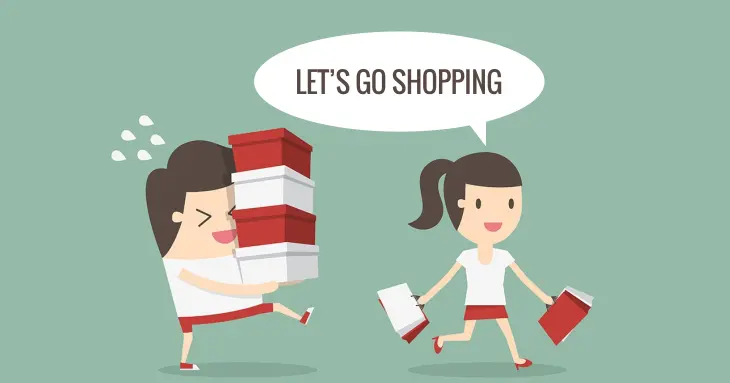We live in a world that surrounds us with many sorts of addictions. When hearing about “addiction”, many people would only think of drug addiction, alcohol addiction and, at most, tobacco addiction. But the truth is that “addiction” takes many shapes – including being addicted to people, to food, to the Internet and, of course, to shopping.
Being a shopaholic can affect one’s life almost as drastically as cocaine addiction. In one way or another, the two are quite similar and they can both take over one’s life almost over the night. Which are the most important things you should know about being a shopaholic and how can it really affect your life?
We have gathered some of the most important bits of information you should know about being a shopaholic and what it really means so make sure to read on and find out more.
In this guide... [hide]
Being a Shopaholic – Is It Truly an Addiction?
By definition, addictions take over a person’s ability to control himself/herself. Some people believe that being a shopaholic is not an actual addiction, but a bad habit that can be controlled if one has enough willpower.
On the one hand, you would be tempted to believe these people. If you have a shopping problem, you should simply quit, right? You should simply stop shopping and you should start taking responsibility for the 20 pairs of shoes you’ve bought this year.
And yet, things are never this simple with shopping addicts. Yes, being a shopaholic is an actual addiction and it can take over one’s life just as strongly as being addicted to cocaine.
If you just stop and listen to the confessions of a shopaholic, you will realize that the urge for just another “dose” is very much similar to the urge of sniffing just another line, of having just another pill, another bottle of wine or another joint. It’s all the same.
Being a Shopaholic – The Science Behind It
Yes, a shopaholic’s addiction can be explained, at least in one way or another, by science. In essence, when a shopaholic buys something, his/her brain releases endorphins and dopamine – chemicals in the brain that make people feel good.
When the behavior is repeated (almost obsessively, sometimes), the brain becomes addicted to the dopamine and endorphins released and it “asks for more” – just as in the case of cocaine addiction, prescription drug addiction or alcohol addiction as well.
Types of Shopaholics
Many people would only classify as “shopaholic” people who simply buy a lot, but that is actually a poor understanding of the term. Truth be told, there are many types of shopaholics out there and it is important to get familiar with the main “typologies” in order to spot one – whether it is yourself that may be having this issue or someone dear to you.
For example, some people shop when they are faced with emotional distress – and for them, the dopamine dose brings them back to the surface. Other people shop because they are collectors that obsess over the idea that not shopping would automatically lead them to feeling incomplete – so they always search for that “one more item” to add to their collection.
There are also people who shop for “trophies”, meaning that they always search for the perfect items and that they get their “rush” when they can find it, only to later on realize that the previously “perfect” item was not perfect – which gets them back into the stores.
Other shopaholics shop for bargain items and they spend their money on items they do not necessarily need, but simply buy them because they are on sale – by this justifying in one way or another their action.
Some people overspend on items because they want to create the image of being big spenders as well. Most of the times, the items these people buy are extremely flashy and way beyond their means, which very frequently gets them in huge financial trouble in the end.
Last, but definitely not least, there is a group of shopaholics many would not necessarily classify as being addicted to this “habit”. They are the “bulimic shoppers”, the people who are constantly buying and “purging” themselves by returning items because they feel guilty – just as a bulimic would purge the food he/she over-ate.
The Profile of a Shopaholic

Extreme Shopping
As you have seen, shopaholics come in many “shapes” and “colors”, but there are things that are quite common to them all. What is the profile of a so-called shopaholic and which are the things that characterize him/her? Here are some of the most important things you should know:
- Most shopaholics feel the urge to buy something new at least once in a few days or once a week. They are not confined to a certain space where they may feel this urge: some of them feel it at home, others feel it while working and others experience it when driving.
- There is a constant “need”. Shopaholics don’t buy new items because they want them – or so they say. They almost never admit wanting to buy something and they very frequently replace want with need. A shopaholic will need “that Manolo pair of shoes” this week and he/she will need that “cute bag” the next one – even if they already have 40 pairs of shoes and 30 bags at home (some of which have never been worn, actually).
- Many of the shopaholics end up in huge debt, without even being conscious of it. The empty credit cards and the late bills usually remind them that they are spending beyond their means and many of these people will feel guilty at the thought, but soon enough another urge will kick in and they will leave guilt aside for just another “dose”.
What Are the Causes of Shopping Addiction?
There are many ways shopping addiction can install in a person. Some people get to be addicted to shopping because they feel “empty” or “bored”. Other people are highly influenced by their groups of friends or by the fact that they suddenly make more money than they used to. And then there are other people who are usually struggling with depression and anxiety as underlying causes of their addiction (and this can be true in the case of almost any other addiction out there too).
On top of all these things, there is a very strong societal component so shopping addiction as well. Whether we like to admit it or not, we live in a world of consumerism and everywhere we turn our heads we are surrounded by ads almost begging us to buy things. We are born and raised in a mentality of buying happiness – and this is definitely not at all helpful for those people who struggle with shopping addictions.
Bear in mind though: going on a shopping spree every now and again cannot be qualified as having a shopping addiction. We all do it, in the end and that’s perfectly normal. However, there are certain “red flags” you should take into consideration (regardless of whether you notice them in your behavior or in the behavior of someone close to you). Here are some of them:
- Hiding credit cards, shopping bags, credit card bills and even deleting a browser’s history to hide all the online shopping
- Lying to the close ones about how much you have spent shopping
- Feeling the need to shop whenever you feel angry or depressed
- Ruining friendships and relationships because of your addiction
- Replacing the guilt of shopping with another shopping spree
- Over-spending almost each time you go out to shop
- Feeling like you have completely lost control over how much you shop, when you do it and why you do it
- Feeling “wild” or “high” after going through a shopping spree
- Feeling euphoric when shopping
- Buying things that you don’t use or wear
- Constantly thinking about money
Unlike other types of addictions, shopping addiction does not have any physical “symptoms” or “red flags”. A shopaholic can look just and feel (at a physical level) just as good as a person who does not have this addiction. The only physical sign of an addiction to shopping is the financial decline – and this usually does not appear to be obvious until the last stage of the addiction.

Shopping Bliss?
How Does It Affect Your Life?
Like every other addiction in the world, being addicted to shopping can affect one’s life to the maximum. Most of the times, the main outcome of being a shopaholic is having financial issues. Some people get in extreme debt and even end up refinancing their mortgages to “fuel” their addictions.
Also, shopping addiction can alter the relationships with those around you. Many times, shopaholics end up getting divorced and they end up not having a good relationship with their children as well – precisely because their spending habits and their lack of involvement in relationships eventually affect them to the point of no return.
Is There Any Treatment?
Treating a shopaholic is really difficult because, like in the case of binger eaters and bulimic people, you cannot completely give up on shopping. You can give up on alcohol, drugs and cigarettes, but living a life without shopping for one thing is quite impossible.
Counseling sessions are usually the primary way in which shopping addicts get treated. Sometimes, a psychologist or a psychiatrist will also treat the underlying disorders as well (depression, for example).
Also, studies show that a drug used in treating Alzheimer’s patients (memantine) can help addicts keep their behavior under control and think more clearly. However, the drug also comes with several side effects such as sleep issues, fatigue, headaches, nausea and so on.







